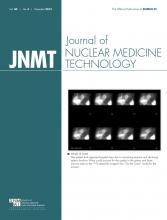
Norman E. Bolus, MSPH, MPH, CNMT, FSNMMI-TS
As I approach the end of my first year as Editor of the JNMT, it is hard for me to believe the time has gone by so quickly. It seems that as I grow older the ends of things lie closer—right around the corner—and appear more quickly, especially the end of each year. Perhaps I am busier or somehow time has moved more quickly; something tells me it is the latter rather than the former. In pondering the end of this year, I feel that I would be remiss if at this juncture I did not at least comment on the Mayan prediction so many people have quoted that the end of something will occur on December 21, 2012, give or take about 1 day for percentage error. The Mayans must have been good observers and recorders of nature to have developed without the aid of modern computing power their cycles of seasons and astronomic rotations. They came up with a system that represented a year as a 365-day solar calendar with 19 months and a long-count calendar that lasted 7,885 solar years. A “great cycle” of the long count consisted of 13 baktuns, with each baktun being 394.25 years and 13 being 5,125.25 years. The end of this long-count great cycle has been determined to correspond on our modern calendar to December 21, 2012. Many media outlets and movies have suggested that this date represents a prediction of the end of the world. Such proposals have been made as that a galactic alignment will occur and a black hole will wreak havoc on the earth or that the earth’s magnetic field will reverse, exposing the earth to cosmic radiation in the process. The Mayans really did not predict anything other than the end of their calendar. No one knows what that actually means except that the next baktun begins and the cycle of 5,125.25 years starts over. So, I will wait and see what happens, thinking about “what if the Mayans are right” possibilities along the way.
Of course, I can remember the prediction of the Y2K problem that was to occur on January 1, 2000—a problem that some thought could bring about the end of the world. There was great concern that all computers would mistake the year 2000 for 1900 and shut down. When computers were first being developed, programmers used a 2-digit year instead of a 4-digit year because 4 digits required 4 bits of information whereas 2 digits required 2 bits, and at that time every bit or byte of information was utilized just to keep the systems going. For example, the entire computing power of the Apollo 11 spacecraft was 2 kilobytes of memory and 32 kilobytes of storage total, whereas today, how many of us carry around at least a 1-gigabyte memory key of external storage? After a lot of hard work to correct, patch, or develop programs to fake computers into believing the date was not January 1, 1900, the world did not end. There have been other end-of-the-world predictions from time to time, and none has yet come true.“What the caterpillar calls the end of the world, the master calls a butterfly.”
—Richard Bach
In this December edition of the JNMT, we have another 2 opportunities for continuing education credit: “A Practical Guide to Quality Improvement in Nuclear Medicine,” by Mary Beth Farrell and Sue Abreu, and “A New Era of Clinical Dopamine Transporter Imaging Using 123I-FP-CIT,” by Eunkyung Park. I believe you will find both articles to be helpful and informative. We continue to need authors for continuing education articles and are currently looking for authors to write on the following topics: standard precautions for the NMT, interventional/adjunctive pharmaceuticals and contrast agents and their use in nuclear medicine, coronary artery disease and PET/CT, and pearls of wisdom and possible pitfalls of image processing. Please let me know if you are interested in writing on one of these topics or if you have any suggestions for future continuing education articles. This December edition has, in addition to the 2 continuing education articles, articles on imaging, radiation safety, instrumentation, professional development, and radiopharmacy, as well as several interesting case reports, 2 book reviews, and a practice guideline on guidelines. Also, go to www.snm.org/facebook and join a discussion that I will begin on what you would do if the end were near.
Finally, as 2012 comes to a close, I would like to thank all the staff and personnel in the SNMMI office for their continued hard work and dedication to our field. As Editor of the JNMT, I have had firsthand experience with their incredible work ethic and awe-inspiring, never-ending drive to help, support, and do the business of our professional society. They deserve credit for everything we call the SNMMI, and without them we would not exist.







